Medium Size Poodle
The beautiful Rhodesian Ridgeback from South Africa has been gaining more followers in Europe for years. No wonder, as this robust hunting companion and family dog fascinates with its proud nature combined with a friendly gentleness towards its loved ones. However, to keep "Ridgies" in a species-appropriate manner, you need a wealth of knowledge about the breed.
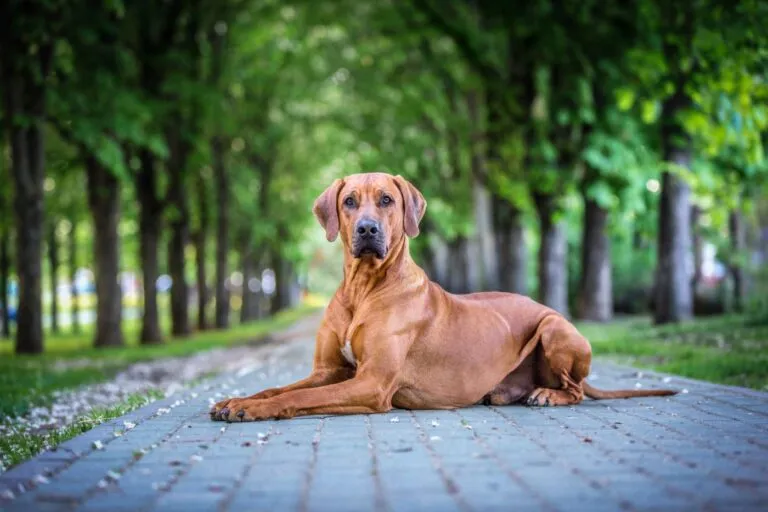
© Osetrik / stock.adobe.com
The Rhodesian Ridgeback is proud, beautiful, and not a dog for beginners.
The appearance of this breed is not always uniform, but all Ridgebacks share a rustic look. When people began breeding this dog breed, the goal was primarily functionality. You can see this in their build: powerful and muscular, but never bulky.
The breed owes its name to a distinctive visual feature: a raised strip of fur running down the back, with hairs growing against the grain.
This ridge starts clearly defined just behind the shoulders and narrows towards the hips.
The wheat-coloured to light red fur is short and smooth. According to the breed standard, small amounts of white or black hairs are only desirable in specific areas such as the chest or toes.
Males can weigh around 36.5kg and have a withers height of 63 to 69cm. Females can reach a size of up to 66cm. This makes Ridgies a large dog breed.
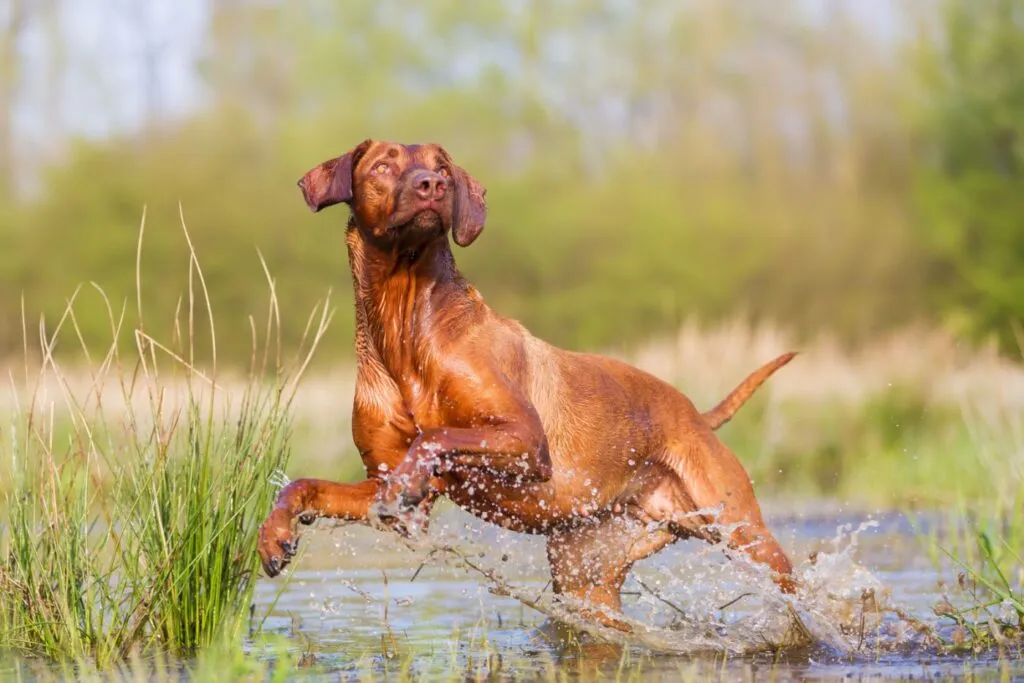 © Christian Müller / stock.adobe.com
© Christian Müller / stock.adobe.com
Lively and loyal, clever and headstrong – the character of a Rhodesian Ridgeback sparks interest in many dog lovers. However, only with expert training and lots of exercise will you be able to manage its pronounced territorial behaviour and high readiness to defend.
If you succeed, you will have a friend for life in the Rhodesian Ridgeback. However, it usually remains reserved towards strangers, both dogs and people, without being aggressive or shy.
Even experienced dog handlers face challenges with the self-confident and headstrong Rhodesian Ridgeback. It requires a lot of consistency and positive motivation, as this intelligent four-legged friend quickly loses interest under pressure.
You should therefore maintain the right balance between loving firmness and patience. Positive reinforcement is particularly effective.
Members of this breed are not physically and mentally ‘adult’ until they are around two years old, so the demanding puppy and teenage phase lasts accordingly longer. You should consider this during training.
In contrast to its training, the coat care of a Rhodesian Ridgeback poses no challenge. The short fur has no undercoat and sheds relatively little outside of the moulting season.
Naturally, your furry friend will still appreciate regular brushing. Indulge it in this pleasure, which is also good for its health. The massage not only removes dead skin flakes but also stimulates blood circulation.
Additionally, check its eyes and ears briefly each day. Remove any dirt with a damp cloth.
The Rhodesian Ridgeback usually keeps its claws in shape by walking on hard surfaces like asphalt. If your dog is already a bit older, you may need to trim its claws with a claw cutter.
The breed is not for beginners and should be in the hands of experienced dog owners. These doggy friends need plenty of space and lots of activity. Due to their strong need for exercise, they are not suited for apartment living or city life.
In a family setting, ensure that children can enjoy an excellent friendship with the Rhodesian Ridgeback but should already be old enough to understand basic rules for respectful interactions with pets.
You can generally socialise your dog with cats if this is done during the puppy stage. However, it may view stray cats as prey. Therefore, a high fence around the garden is highly recommended.
Speaking of gardens: if your garden is perfectly maintained, you will need to say goodbye to that state. Your Ridgeback will soon transform it from a blooming oasis into a hole-riddled natural garden.
Originally, these athletic dogs had lots to do: guarding house and homestead along with livestock, hunting, and protecting their owner. Today, many Rhodesian Ridgebacks are still used as guard dogs, protection dogs, hunting dogs, or tracking dogs.
They also have the right instincts to be trained as rescue dogs or mantrailers.
You must ensure that your Rhodesian Ridgeback is well-exercised. These fast and agile South African canines usually delight in dog sports like agility or obedience. Due to their size, however, avoid making them jump too often to prevent joint problems.
Always research your breeder thoroughly beforehand. Because dogs that mainly descend from pure working lines need particularly high levels of exercise. Give your dog ample opportunity to romp and sniff during daily walks.
You can vary daily walks with tricks, hide-and-seek games, and new routes. An adult Rhodesian Ridgeback will also enjoy accompanying you while jogging or cycling.
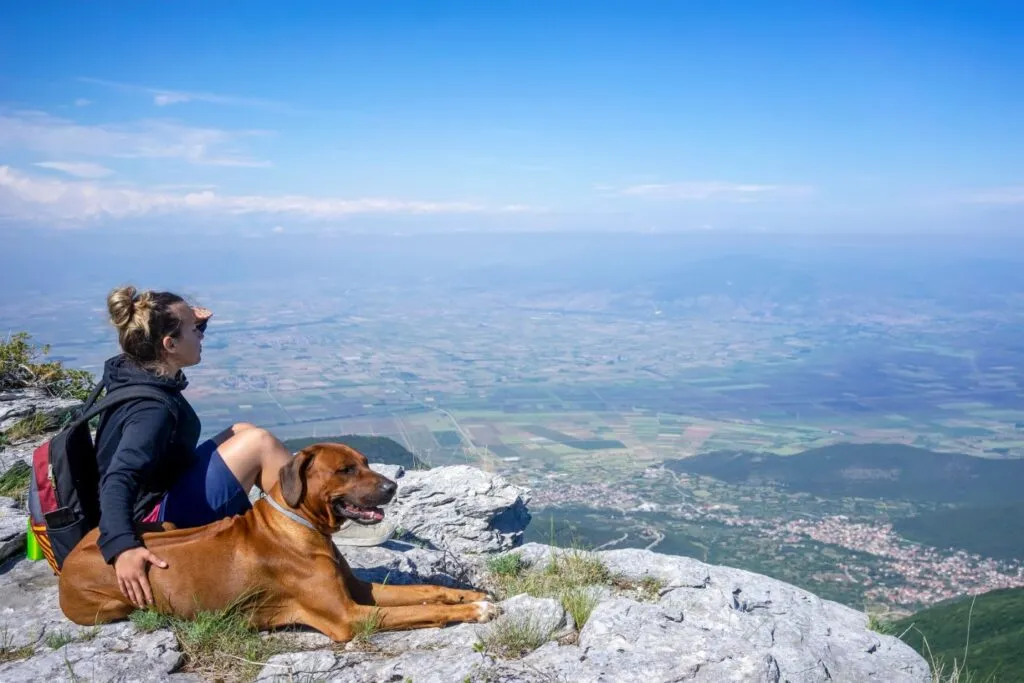 © ververidis / stock.adobe.com
© ververidis / stock.adobe.com
Rhodesian Ridgebacks are beautiful dogs known worldwide for their distinctive dorsal strip of raised fur. This feature is embedded in their breed standards.
However, breeding these beauties is partly controversial in animal welfare. Thus, breeding Ridgies under certain conditions can be regarded as compromised breeding, which is why you must inform yourself about the breed’s genetic health and local regulations.
Due to the connection between the skin and spinal cord, affected dogs suffer from hypersensitivity and hind limb paralysis.
Furthermore, dangerous infections can occur, leading to inflammation of the meninges or spinal cord. About 10% of affected puppies have spina bifida, a split spine.
The “Expert Opinion on the Interpretation of § 11b of the Animal Welfare Act (Prohibition of Compromised Breeding)” published in Germany recommends banning the breeding of animals with dermoid cysts.
Apart from this, the Rhodesian Ridgeback is considered robust. It usually tends to develop hip dysplasia and elbow dysplasia, like all large breeds.
Because of its African roots, the breed has relatively thin fur, especially in the belly area. This can lead to the animals feeling the cold quickly in winter.
Ensure that your four-legged friend has a cosy spot at home during the cold season and does not have to stay in one place outside for too long. A dog coat is also an option.
If you buy your Rhodesian Ridgeback from a responsible breeder and keep it in a species-appropriate manner, it can accompany you from puppyhood for up to twelve years.
The right diet is one of the cornerstones of a healthy and animal-friendly dog life.
While dry food may be very convenient, many dogs prefer wet food and it also provides them with fluid. This is particularly advantageous for Rhodesian Ridgebacks, as some tend not to drink enough water. Therefore, many breed experts recommend offering only wet food. The protein source should always be high-quality.
BARF-ing is also an option for Rhodesian Ridgebacks, provided you prepare the rations in a species-appropriate manner and with the required hygiene measures.
While a puppy needs three to four meals a day, an adult dog will do well with two portions daily. When changing food, never do this abruptly from one day to the next. Instead, give your Rhodesian Ridgeback’s stomach time to adjust.
Generally, keep an eye on your dog’s weight. Use the manufacturer’s feeding recommendations as a basis for calculating the daily amount of food.
However, adjust the amounts to your dog’s activity level to avoid excess weight. Also, consider the portion of treats in the daily amount.
The “Rhodesian” in the name reveals this proud dog’s origin. The relatively young breed comes from the former state of Rhodesia – today’s Zimbabwe – in southeast Africa. Here, enthusiasts defined the first standard in 1922.
However, the ancestors of the Rhodesian Ridgeback come from South Africa, where they have been kept as guard and hunting dogs for centuries. Therefore, South Africa is officially recognised as the country of origin. The Rhodesian Ridgeback is the only breed from South Africa recognised by the FCI.
Interesting to Know: The nickname “Lion Dog” was given to these hunting dogs for their role in lion hunting. Several dogs would track a lion, then hold it at bay by barking until the hunter arrived.
Thanks to the influence of European settlers who crossed its ancestors with breeds like Great Danes, Terriers and Greyhounds, the Rhodesian Ridgeback got its present look.
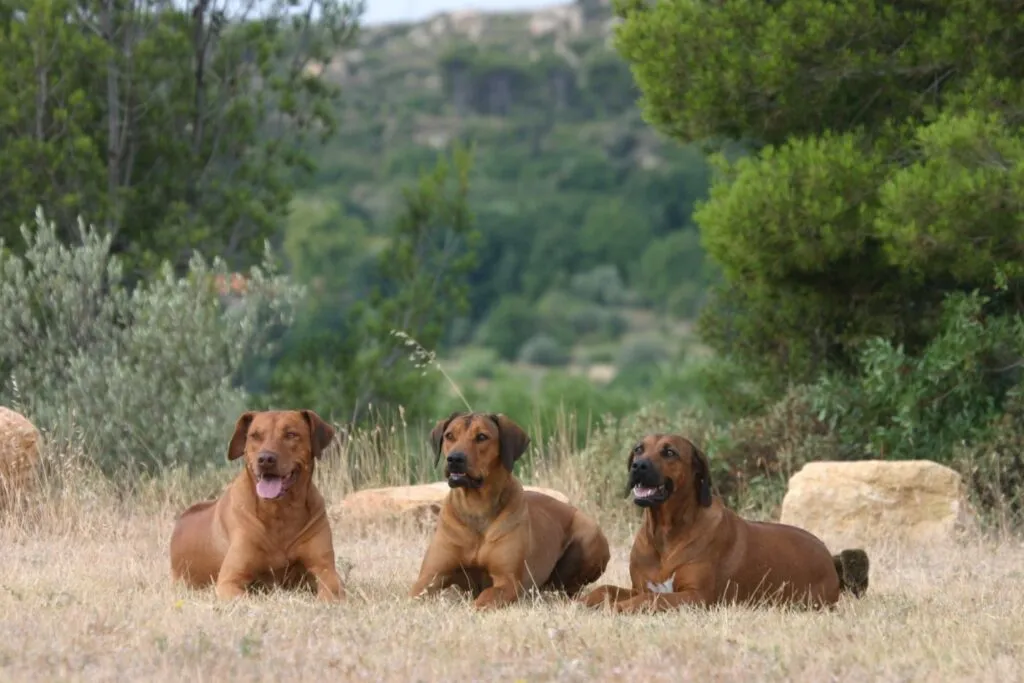 © Dogs / stock.adobe.com
© Dogs / stock.adobe.com
You can best find a puppy at breeders who are members of relevant associations. Only with a pedigree can you be sure that it is a genuine Rhodesian Ridgeback.
Additionally, association members must pass certain breeding tests regarding health, character and type with their four-legged friends before they can breed. This is stipulated in the breeding regulations.
Before buying a puppy, get an idea of its living conditions. Also, ask the breeder all important questions you have regarding the breed. Usually, the breeder will also have some questions to determine if you are suitable candidates for their dogs.
Do you want to offer a fully grown Rhodesian Ridgeback a new home? If the local animal welfare organisation does not have one in its care, searching online is promising. You can also find organisations specialising in rehoming Rhodesian Ridgebacks.
However, consider that some dogs may not have had good training. Always gather extensive information about the dog’s background from the rehoming organisation.
Usually, welfare organisations quickly determine if you and the four-legged friend are a good match during a conversation. Ideally, you can get a comprehensive personal impression of the dog at a meeting.
The purchase price of a representative of this breed can vary greatly depending on age and origin. Prices of at least £1,500 are not unusual for these popular dogs. Additionally, you need to consider initial costs for essentials like bowls, leads and accessories.
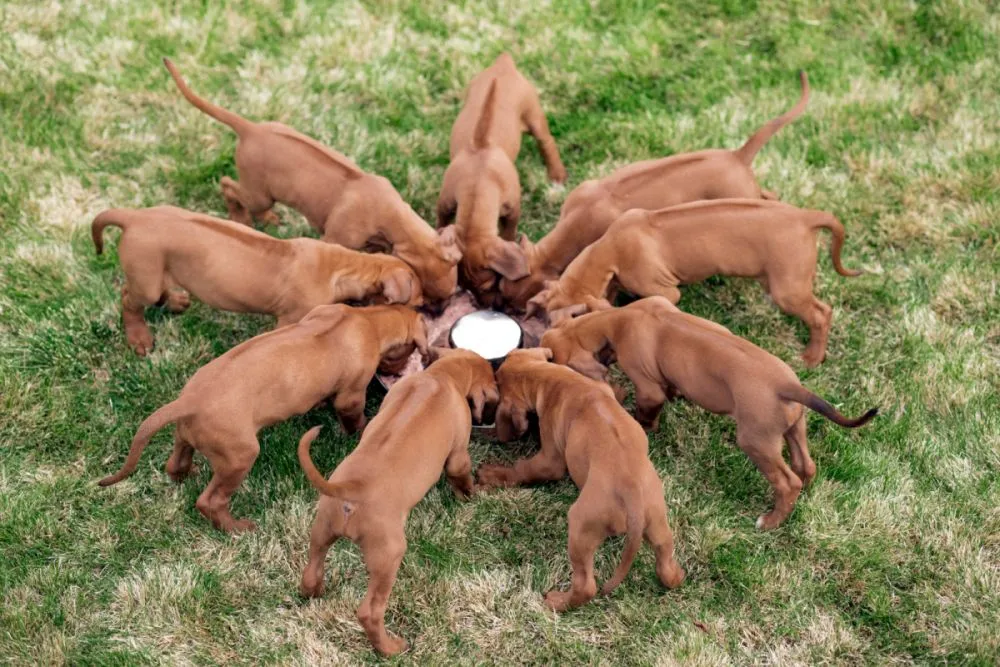 © Mariusz Blach / stock.adobe.com
© Mariusz Blach / stock.adobe.com
The breed is suitable only for experienced dog owners who can offer their four-legged friend plenty of space and are also physically active. These strong dogs with a great urge to move do not belong in small flats or grey cities.
Even under optimal conditions, you should critically assess whether you can handle the responsibility for this special dog for many years. All family members in your household should agree with the new family dog and be allergy-free.
| Quick Info: | The large Rhodesian Ridgeback has a powerful build and lots of self-confidence. It is a popular family dog but only belongs in experienced hands. |
| Withers Height: | 63-69cm |
| Weight: | approx. 36kg |
| Average Life Expectancy: | 12 years |
| Price: | from 1,500 Pounds |
| Temperament: | lively, loyal, clever, headstrong, self-confident |
| Fur: | short and smooth |
| Fur Colour: | wheat-coloured to light red |
| Training Effort: | medium |
| Care Effort: | low |
| Exercise Needs: | high |
| Country of Origin: | South Africa |
Fans of the Bearded Collie agree that those who aren't familiar with this dog breed simply have to get acquainted with it. And those who have experienced how a Bearded Collie bolts across meadows with its flowing fur, how it rolls around full of energy and joy and how it attentively and observantly takes into account its owners wishes become simply addicted to this original dog breed and its unique charm.
The Goldendoodle isn't a breed, but a pairing between Golden Retrievers and Medium or Standard Poodles. Marketed as a low-maintenance dog for allergy sufferers, this hybrid is enjoying increasing popularity amongst dog lovers, similar to the Labradoodle.